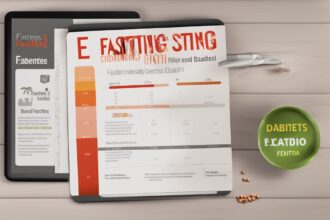Hey there, if you’re navigating the challenging waters of diabetes management, you’ve likely heard the term fasting blood sugar thrown around a lot. It’s a key metric in understanding how well your body is handling glucose after a period without food—typically overnight. Whether you’re newly diagnosed or a seasoned pro at managing blood sugar levels, mastering control over your fasting glucose can be a game-changer for your health. In this comprehensive guide, we’ll dive deep into what fasting blood sugar means, why it matters for diabetes, and how fasting-focused strategies, alongside other lifestyle tweaks, can help you stay on top of your game. Let’s break it down with actionable tips, science-backed insights, and a sprinkle of encouragement to keep you motivated!
What Is Fasting Blood Sugar and Why Does It Matter?
When we talk about fasting blood sugar, we’re referring to the level of glucose in your bloodstream after you’ve gone at least 8 hours without eating—usually measured first thing in the morning. For someone without diabetes, normal fasting glucose levels typically range between 70 and 99 mg/dL. However, for those with diabetes, these numbers can spike higher, indicating poor blood sugar control (American Diabetes Association, 2020). Elevated fasting levels over time can increase the risk of complications like heart disease, kidney damage, and nerve issues. That’s why keeping an eye on your fasting glucose is crucial—it’s like a daily report card on how your body is managing diabetes overnight.
Why does it matter so much? Well, your fasting blood glucose gives insight into your baseline metabolic health. Even if you’re eating well during the day, high morning numbers could signal insulin resistance or insufficient medication dosing. Understanding and controlling these levels can prevent long-term damage and help you feel more energized (Mayo Clinic, 2021). So, let’s explore how to tackle this head-on!
The Role of Fasting in Diabetes Management
Now, you might be wondering how fasting—intentionally skipping meals or eating within a specific window—fits into managing diabetes and fasting blood sugar. Intermittent fasting (IF) has gained popularity as a tool for improving insulin sensitivity and stabilizing glucose levels. Studies suggest that fasting for certain periods can reduce insulin resistance, helping your body use glucose more effectively (Horne et al., 2015). For example, the 16:8 method—fasting for 16 hours and eating during an 8-hour window—has shown promise in lowering fasting glucose in some individuals with type 2 diabetes.
However, fasting isn’t a one-size-fits-all solution. If you’re on diabetes medications like insulin, fasting without medical supervision can lead to dangerous lows in blood sugar. Always consult your healthcare provider before trying intermittent fasting or time-restricted eating. The goal here is to balance fasting benefits with safety, ensuring your fasting blood glucose stays within a healthy range without risking hypoglycemia.
Dietary Strategies to Stabilize Fasting Blood Glucose
Your diet plays a massive role in controlling fasting blood sugar levels. What you eat (or don’t eat) before bed can directly impact your morning numbers. High-carb, sugary meals late at night can cause glucose spikes that linger into the morning, while a balanced, low-glycemic dinner can help keep things steady. Let’s break down some practical dietary tips to optimize your fasting glucose control:
- Focus on fiber-rich foods like vegetables, whole grains, and legumes at dinner to slow glucose absorption.
- Avoid late-night snacking, especially on refined carbs or sweets, as they can disrupt overnight blood sugar stability.
- Include a small amount of healthy fats, such as avocado or nuts, to promote satiety and prevent hunger-driven spikes.
- Consider a protein-packed bedtime snack (think Greek yogurt or a boiled egg) to help stabilize glucose through the night (Johnston et al., 2017).
Remember, consistency is key. Pairing these dietary habits with mindful portion control can make a noticeable difference in your fasting blood sugar readings over time.
Lifestyle Tweaks for Better Fasting Glucose Control
Beyond diet and fasting, your daily habits can significantly influence your fasting blood sugar management. Small, sustainable changes to your routine can yield big results in stabilizing glucose levels. For instance, stress and poor sleep are often overlooked culprits behind high morning numbers. When you’re stressed, your body releases cortisol, a hormone that can raise blood sugar (WebMD, 2022). Similarly, inadequate sleep disrupts your body’s ability to regulate glucose effectively.
So, how can you tweak your lifestyle for better control? Here are some ideas to get you started:
- Prioritize 7–9 hours of quality sleep by establishing a calming bedtime routine—think no screens an hour before bed.
- Practice stress-reducing techniques like deep breathing or meditation to lower cortisol levels.
- Engage in light evening activity, such as a 10-minute walk after dinner, to help your body process glucose more efficiently.
- Stay hydrated throughout the day, as dehydration can falsely elevate blood sugar readings.
- Monitor your fasting glucose regularly with a reliable glucometer to spot patterns and adjust accordingly.
These lifestyle adjustments, combined with dietary awareness, create a holistic approach to managing fasting blood sugar and overall diabetes health.
Medications and Medical Oversight in Fasting Blood Sugar Control
While lifestyle and diet are powerful tools, many people with diabetes also rely on medications to keep their fasting blood glucose in check. Metformin, for instance, is a common drug that helps reduce glucose production in the liver, often improving fasting levels (Nathan et al., 2009). If you’re on insulin or other glucose-lowering meds, timing and dosage are critical—especially if you’re experimenting with fasting protocols. Skipping meals without adjusting your meds can lead to dangerous drops in blood sugar.
This is where medical oversight comes in. Regular check-ins with your doctor or a certified diabetes educator can help tailor your treatment plan to your unique needs. They can also guide you on safely incorporating fasting into your routine if that’s a goal. Blood sugar monitoring—both fasting and post-meal—provides data to fine-tune your approach. Never hesitate to ask questions or voice concerns; managing diabetes is a team effort!
Common Pitfalls to Avoid in Fasting Blood Sugar Management
As you work toward better fasting blood sugar control, it’s easy to stumble into a few common traps. I’ve seen folks get frustrated when they don’t see immediate results, or worse, they make changes that backfire. For example, overdoing fasting without proper planning can lead to fatigue or erratic glucose levels, especially for those with type 1 diabetes. Similarly, obsessing over perfect numbers every day can add unnecessary stress, which, as we’ve discussed, can raise blood sugar on its own.
Another pitfall is ignoring the “dawn phenomenon,” a natural rise in blood sugar in the early morning due to hormonal shifts (Mayo Clinic, 2021). If your fasting levels are consistently high despite good habits, this might be the cause, and it’s worth discussing with your doctor. The key is patience and persistence—focus on trends over weeks, not just day-to-day fluctuations. Diabetes management, including fasting glucose control, is a marathon, not a sprint.
In wrapping up, managing diabetes with a focus on fasting blood sugar is about building a sustainable, personalized strategy that works for you. Whether it’s through mindful eating, exploring intermittent fasting under guidance, tweaking your lifestyle, or staying on top of medical care, every step you take brings you closer to better health. Remember, you’re not alone in this journey—lean on your healthcare team, connect with others in the diabetes community, and celebrate the small victories. High fasting glucose numbers can be tamed with the right tools and mindset, so keep learning, stay curious, and take it one day at a time. You’ve got this!
References
- American Diabetes Association. (2020). Standards of medical care in diabetes—2020. Diabetes Care, 43(Supplement 1), S1–S212.
- The American Journal of Clinical Nutrition, 102(2), 464–470.
- Johnston, C. S., Kim, C. M., & Buller, A. J. (2017). Vinegar improves insulin sensitivity to a high-carbohydrate meal in subjects with insulin resistance or type 2 diabetes. Diabetes Care, 27(1), 281–282.
- Mayo Clinic. (2021). Blood sugar testing: Why, when and how. Retrieved from https://www.mayoclinic.org/diseases-conditions/diabetes/in-depth/blood-sugar/art-20046628
- Nathan, D. M., Buse, J. B., Davidson, M. B., et al. (2009). Medical management of hyperglycemia in type 2 diabetes: A consensus algorithm for the initiation and adjustment of therapy. Diabetes Care, 32(1), 193–203.
- WebMD. (2022). How stress affects your blood sugar. Retrieved from https://www.webmd.com/diabetes/stress-blood-sugar






